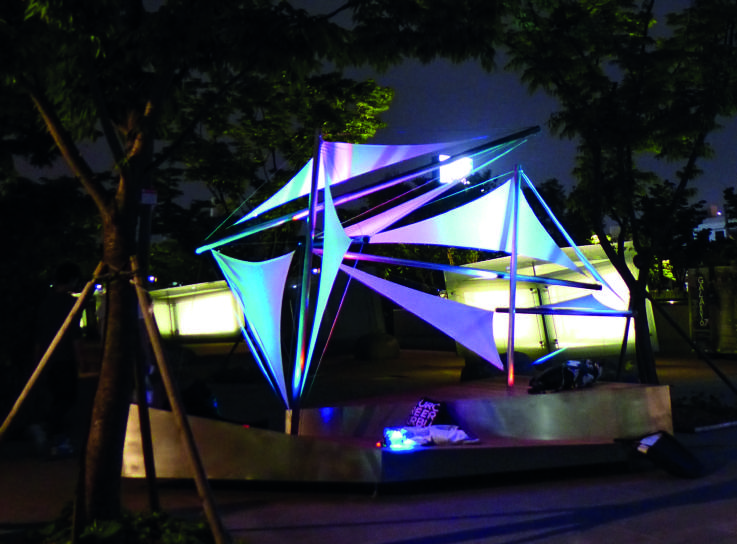Hunting for Gwangju’s Follies

Written by Kelsey Rivers
Photos courtesy of Gwangju Folly
A golden pavilion, standing at a crossroads, swirling with revelers on a Friday night. Stark concrete stairs leading to nowhere, people reclining on the steps, waiting for their buses to whisk them away. A sidewalk lit up by alternately colored, softly glowing, suspended boxes that turn an otherwise drab street magical. If you have wandered the streets of downtown Gwangju, you must have surely noticed structures in the most unusual of places, decorative, but perhaps functional, as well.
But what are they? These public art works are another endeavor in Gwangju’s push towards being a global hub for culture and arts. The first of these works appeared during the 2011 Gwangju Biennale, the result of “Gwangju Folly,” first conceived by the curators of the Biennale, Seung Hyo-sang and Ai Wei Wei.
Beginning with Gwangju Folly I, over the course of the next consecutive Biennales, Folly II and Folly III have also made an appearance in the artistic landscape of Gwangju. The works associated with the Folly projects are primarily the creations of international designers, who contribute to one of the explicit goals of the Folly projects: to “boost Gwangju’s image as a design city.” By having international designers contribute to the projects, Gwangju is co-opting some of their “brand name power” in branding itself.
The term “folly” has a very specific meaning in the context of architecture. A “folly” is a structure that has lost its functional purpose, and instead, simply plays a decorative role in an environment. Follies, in fact, are noted for being spaces that do not necessarily work cohesively with the environment, or created space, in which they are situated, but are “strategic places of madness and satire freed from the constraints of societal norms (gwangjufolly.org).”

The Gwangju Folly projects (which is what they are now becoming, projects of their own outside of the Biennale), take follies as a “new and creative spatial alternative that is able to overcome contextual limitations of existing urban cities and facilitate greater communication with the public (gwangjufolly.org).” That is, unlike other follies, which exist for primarily aesthetic purposes, as “frivolous spaces,” the Gwangju Follies are meant to engage with and reimagine the public spaces of Gwangju.
The first of the Folly projects, Gwangju Folly I, was created with the specific goal of revitalizing the downtown area surrounding the Asia Culture Center. As is the case for the rest of the country, and perhaps the world in general, the forces of globalization and rapid economic development are not kind to the individual idiosyncrasies that mark a place as unique. The downtown area has, for a long time, been experiencing a “hollowing out” and loss of characteristic charm. The Folly projects were meant to help in the regeneration of the area and to contribute a cultural asset to it and to Gwangju, in general. In fact, the first Folly was designed to situate the various installations of the project in key locations of the former Gwangju-eup Castle that used to be located in this area, but over the course of time has been almost entirely erased. The Folly project is a bridge between the present day and the past, contributing in some small measure to the sense of history that has been stripped from so much of Gwangju over the years for the sake of development.

The Folly projects take some of their inspiration from the May 18 demonstrations as well, a defining moment in the history of Gwangju that has shaped the course of Korean politics and the identity of the city and its citizens. The demonstrations redefined the space in which they took place – what was designed with one purpose in mind was transformed into a space of political fomentation, which triggered a string of repercussions and events stretching far into the future, changing the course of Gwangju’s history. While perhaps with not such grand aspirations in mind, the Folly projects are meant to redefine the spaces in which they are situated.
While there is a distinct pleasure in happening upon the Follies randomly in the course of one’s wanderings around the city, for those of us without such patience, check out gwangjufolly.org for maps and descriptions of the Follies.




